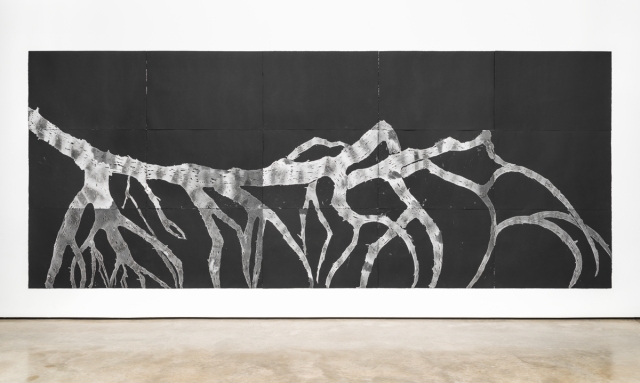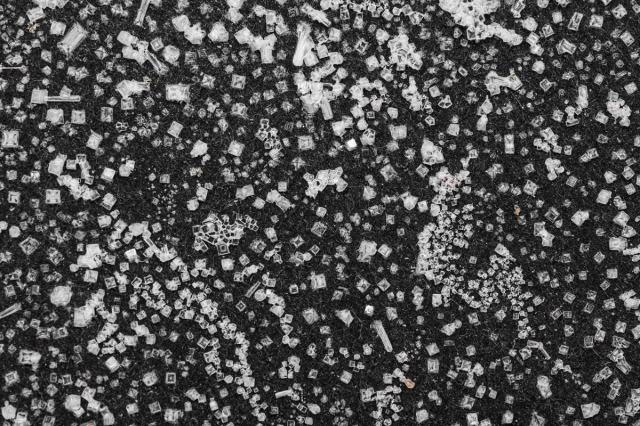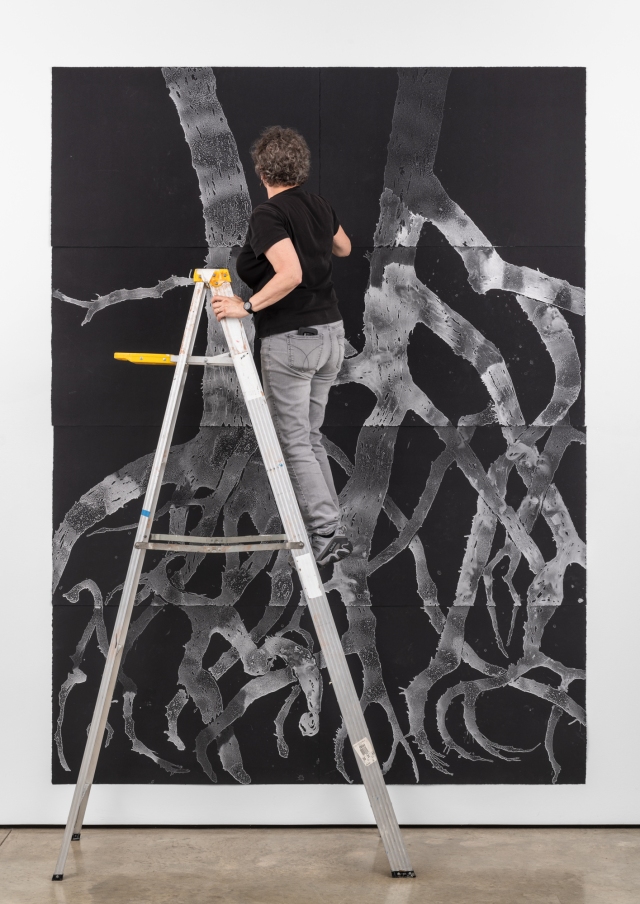
In the late 1970s, artist Madeline Irvine was driving to school in Northern Indiana. She stopped to get gas at a time when people filled up the tank for you, and a young man was on the job. Irvine had several canvases on the back of her station wagon.
The man asked, “What are those?”
“They’re canvases for painting,” Irvine responded.
“Oh. Does your husband do that?”
“There was not even a glimmer in his mind that a woman could be a painter,” Irvine said after telling the story. “It said a lot that someone who was maybe 19 years old didn’t conceive a woman doing anything but taking care of the house, raising kids and cooking.”
Irvine, 65, is a multidisciplinary artist whose work focuses on the natural world. She uses an open range of media to produce her works, though she currently draws and paints with hyper-saturated salt solutions. She earned her bachelor’s in painting from the Maryland Institute College of Art in 1982 and a master’s in painting/printmaking from the Rhode Island School of Design in 1993.

An Austin local, this summer Irvine completed a permanent wall-size art installation at the new Facebook offices downtown and was featured in the Contemporary Austin Crit Group 2019 exhibition, which opened on July 25.

“There are museums that are having a lot more shows of women and their contributions [to the art world],” Irvine said. “I think there are real changes that we haven’t seen in statistics yet.”
Irvine also said that the #MeToo movement has done a lot for women in the arts.
However, it wasn’t always this way.
Throughout her career, Irvine has noticed poor or nonexistent representation of female artists, especially in museums and galleries. In the 1990s, she used to find and paste photographs in her painting journals that displayed gender inequality across different fields, including the exclusion of women in the art world.
“In 1993, I cut out a New York Times magazine cover that showed Arnold Glimcher, who ran Pace Gallery in New York, which was the gallery, for decades,” Irvine said. “It said ‘Arnold Glimcher and his Art World All-Stars,’ and all of [the artists on the cover] were men.”
Historically, the art world has always been male-dominated. Art historian Linda Nochlin explores the absence of “great women artists,” the female equivalents of artists like Picasso or Michelangelo, in her 1971 essay. She concluded institutional obstacles such as the unavailability of nude models to aspiring female artists during the Renaissance up to the 19th century prevented women from succeeding in the field.
Irvine served as director, assistant director and education coordinator for School 33 Art Center in Baltimore from 1984 to 1990. The contemporary art center has exhibitions, workshops and classes to support and showcase local art.
In her time as director, Irvine provided diverse artist panels and fair representation in the selection of artists for the exhibitions at School 33.
“We wanted to make sure that we weren’t showing only white men,” Irvine said.
Irvine wasn’t the only one who noticed the absence of women in American art museums and galleries during the ‘70s and ‘80s.
The Guerrilla Girls, a group of anonymous feminist activist artists, formed in 1985 to expose and combat sexism and racism in the art world. Inspired by the second-wave of feminism that had started in the 1960s, the group launched in response to “An International Survey of Painting and Sculpture,” a 1984 exhibition in New York’s prestigious Museum of Modern Art that showcased the most important contemporary artists at the time. Out of the 165 artists featured, only 13 were women.
The Guerrilla Girls protested the exhibition outside the museum and quickly became famous for their alarming posters with numbers that proved severe female and ethnic underrepresentation in museums and galleries in New York. Members of the group visited different exhibits, counted the number of women and/or non-white artists and created eye-catching posters with the information. The posters were placed around the city at night.
Among the Guerrilla Girls’ most popular findings from 1985 to 1989 was a list of 20 galleries in New York with no more than 10% of women artists or none at all, how women artists earned a third of what men artists did and how less than 5% of the artists in the Modern Art section of the Metropolitan Museum of Art were women but 85% of the nudes were female.
Still active today, the Guerrilla Girls use gorilla masks in public to maintain focus on the issues they protest rather than their individual identities.
The National Museum of Women in the Arts reported women today “remain dramatically underrepresented and undervalued in museums, galleries and auction houses.”
Irvine encourages female artists to support each other. Irvine expressed deep gratitude for two women who have both supported her artwork and helped further her career, one of them used to be her teacher.
“They’ve been wonderful mentors as well as incredible friends,” Irvine said. “It’s a wonderful thing that women can help support each other.”
